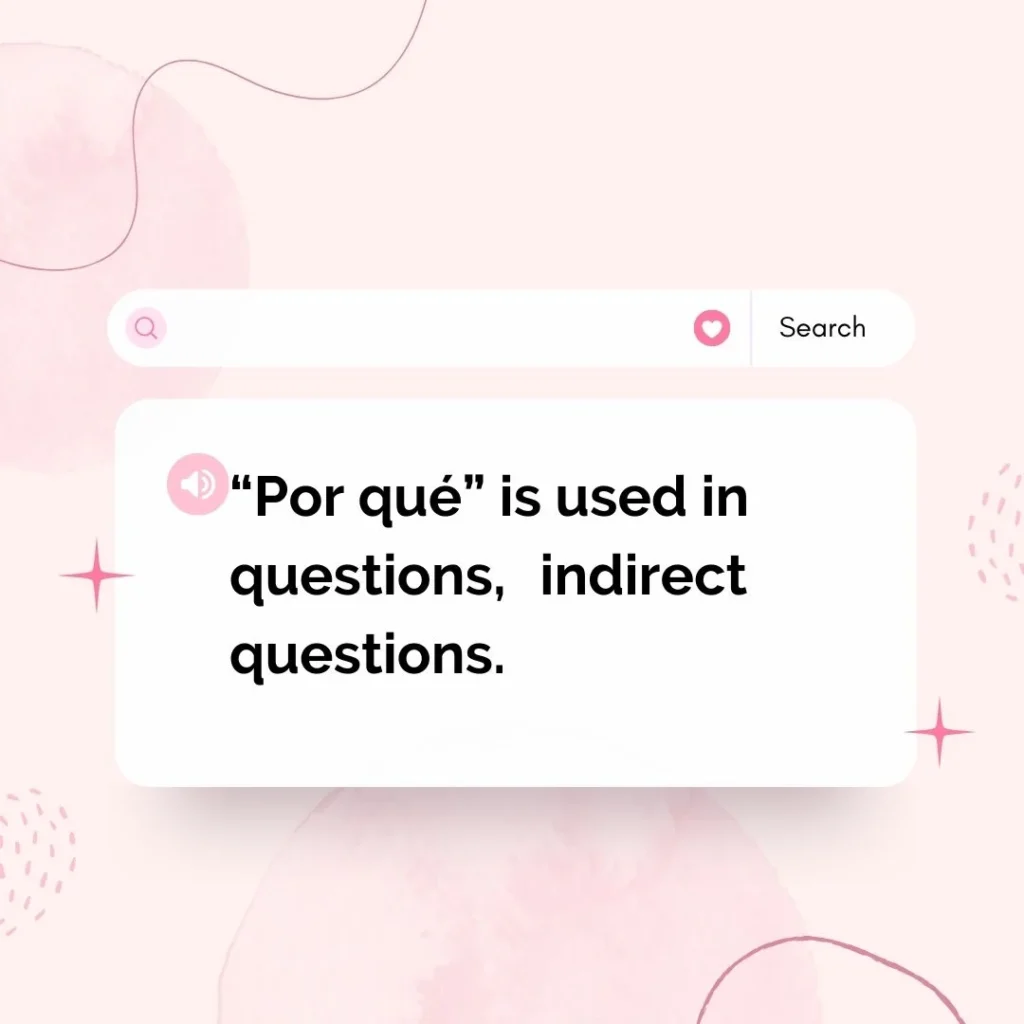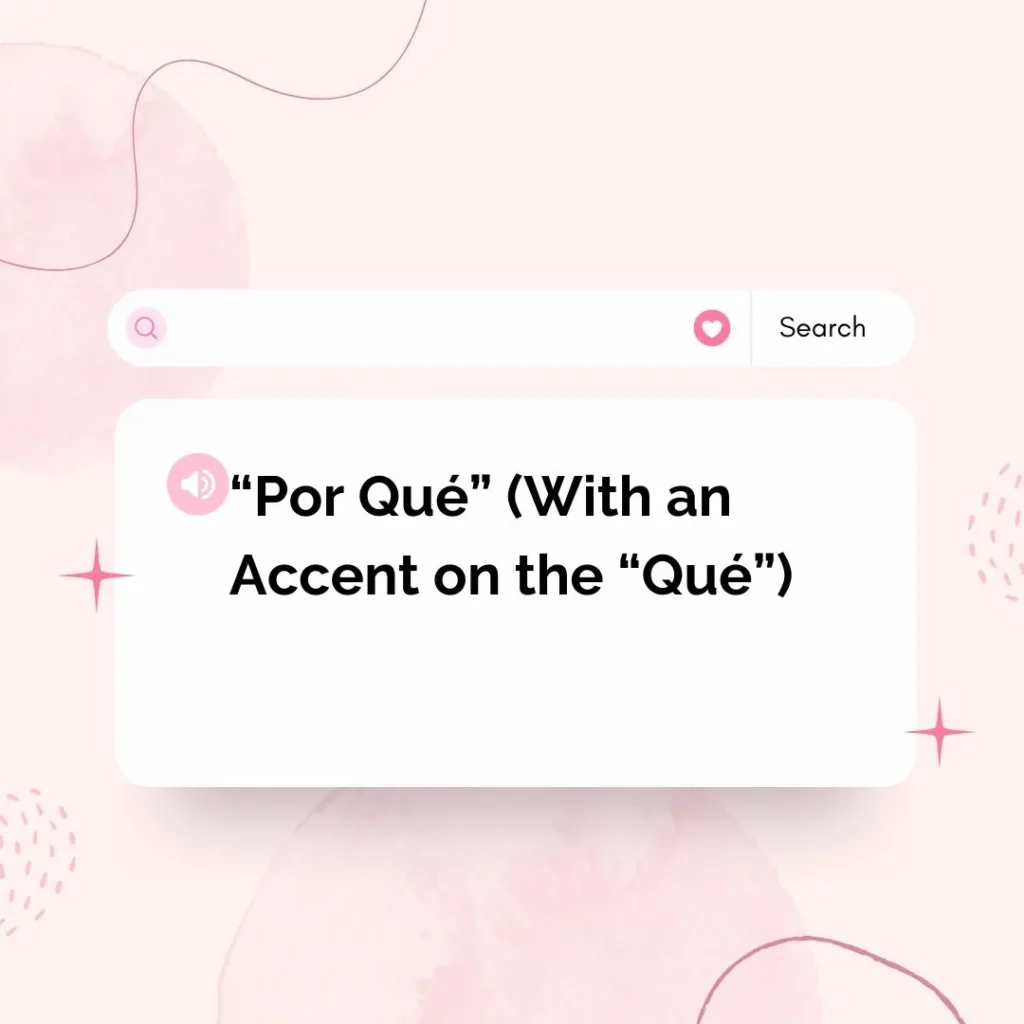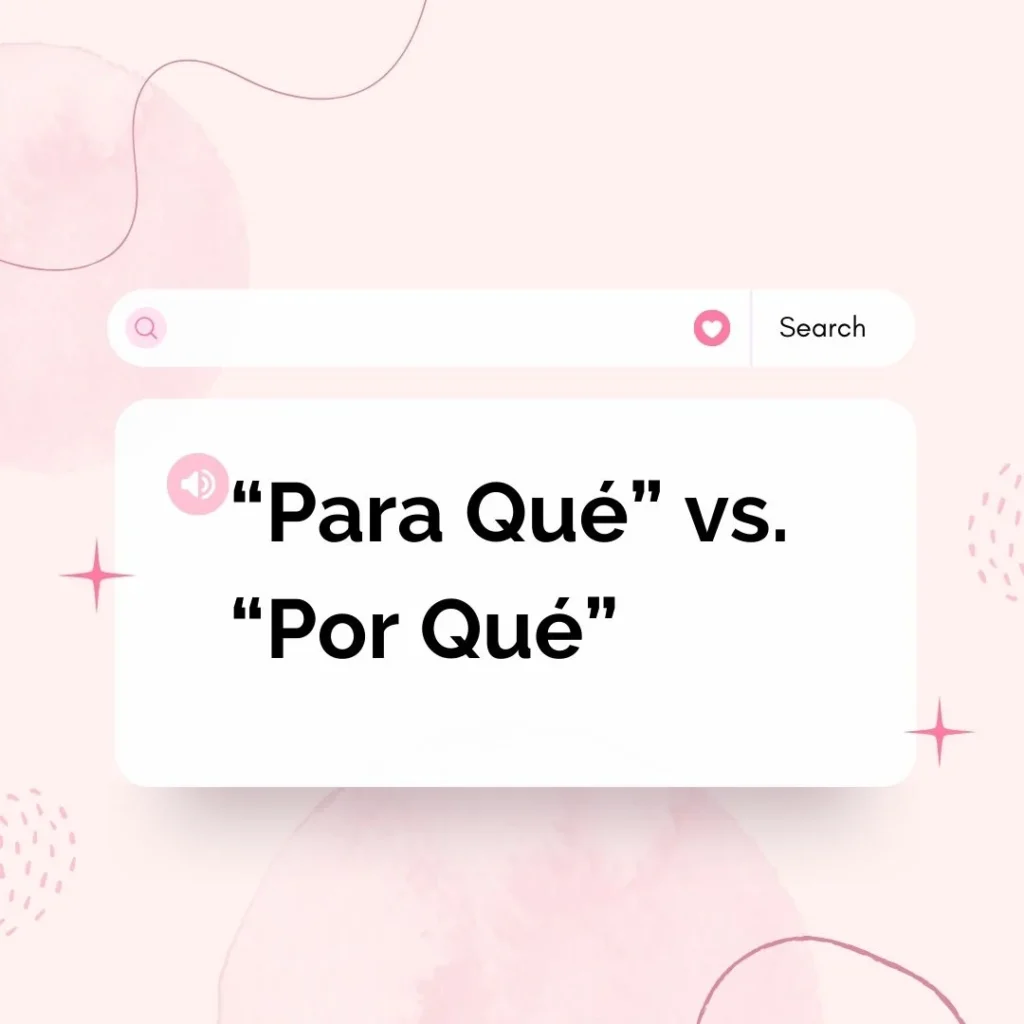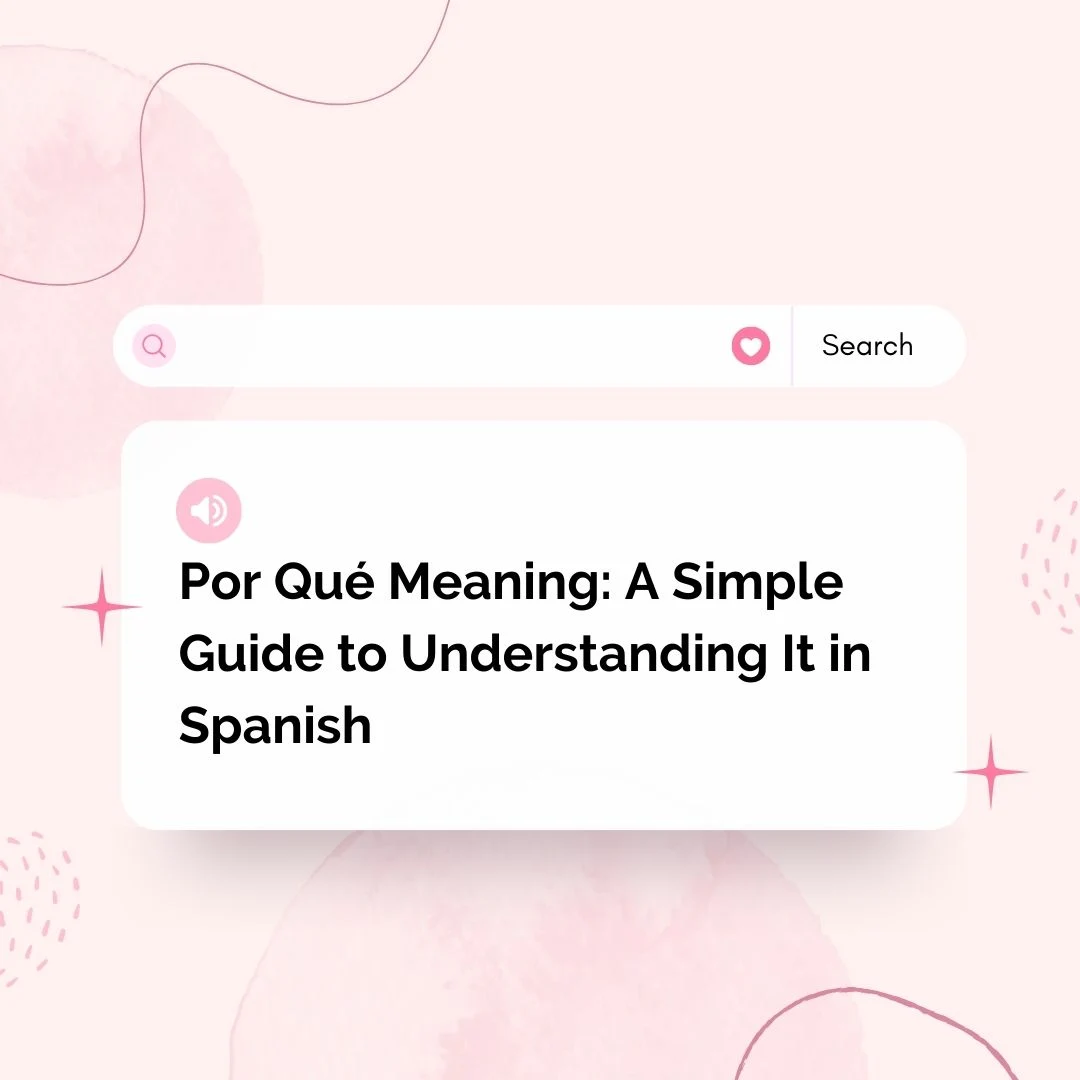Por Qué Meaning: Do you want to know the difference between “por qué”, “porque”, “porqué”, and “por qué”? For Spanish learners, these four phrases can be confusing at first and that’s okay, because you’re not the only one!
If you want to master the language without making mistakes, you need to know the meaning and the usage of “por qué” and its variations.
In this easy guide for 2025, we’re going to explain Por Qué Meaning in every term to you simply, give you some real-life examples, and offer you some quick tips that will help you use them as common expressions.
If you’re a Spanish student, a traveler or someone who loves languages, this guide will make your learning journey easier!
Read on to unravel the mystery of these problematic Spanish idioms and start mastering them today! 🚀
What Does “PorQue” Mean?

On the surface, the phrase “por que” may seem like a simple question: “Why?” But as you get deeper into Spanish grammar, you’ll see it’s not nearly that simple.
It’s because “por que” isn’t actually a single word—it’s made up of two words: “por” (for) and ”que” (that). Combined, however, they frequently come in more sophisticated grammatical formulations.
Common Uses of “Por Que”
“Por que” comes up either when you are using the subjunctive mood, or in slightly stilted constructions.
It occurs in indirect questions or a clause where the cause or reason is explained or emphasized.
In other words, “por que” frequently appears as part of a longer sentence as opposed to being used as an independent expression. Now let’s get into how to use por que and its forms.
| Phrase | Meaning in English | Use |
| Por qué | Why | Asking questions |
| Porque | Because | Answering questions |
| Porqué | The reason | Used as a noun |
| Por que | For which / that | Rare, formal usage |
How to Use “Por Que” in Spanish: Summary The Various Shapes of “Por Que”.
Spanish is a nuanced language, and “por que” is no exception. Though “por que” appears to be a simple phrase, por que.” in fact there are 4 different forms of it, according to the presence of accentuation, sentence structure and its meaning. Here’s a breakdown of each:
“Por Que” (Two Words)
This is the most frequent form you will see, and when and how to use it is something I also feel is important for you to understand.
“Por que” is used in indirect questions and in statements where the reason is not directly asked, but implied.
Sample sentence: I don’t know why you did that.
Aqui o “por que” enunciou a razão do por fazer, porém não empregado de forma direta. There may be a higher usage of this structure in formal or written Spanish.
When to Use It
Use it when you’re bringing in a subordinate clause that explains the reason for something, without actually asking a question.
You see it frequently with idiomatic phrases such as no sé por que (I don’t know why).
“Por Qué” (With an Accent on the “Qué”)

“Por qué” is used in questions, indirect questions. The accent on “qué” tells you that this is a question; it’s asking for a reason… so you get it at the end of a question.
Example sentence: Why didn’t you come yesterday?
The accent on “qué” is important here without it, the meaning is entirely different.
When to Use It
“Por qué” is never used after a statement, only in the event of a question.
It is a feature of many of the most common Spanish question words, like “cómo” (how), “dónde” (where) and “cuándo” (when).
“Porque” (No Accent)
“Because” becomes “porque”—this is the simplest form of the word. It is a conjunction that in a phrase joins a cause with its effect, giving the reason a certain action occurred.
Example sentence: I didn’t go to the movies because I was tired.
(I did not go to the movies due to being tired.)
When to Use It
To explain or for cause: Use “porque.”
It is a typical feature of spoken and written Spanish to provide responses to questions.
“Porqué” (One Word, With an Accent)
It is less frequent but also relevant. “Porqué” is used as a noun and stands for “The reason”. It is often used with an article, such as “el” (the), and it refers specifically to the cause of something.
Sample sentence: The reason for his decision is not clear.
(It’s not clear why he made that decision.)
Por Qué Meaning:When to Use It
“Porqué” is the end result if the reason is spoken of as a noun.
It is often preceded by the article “el” or “un” to express a specific cause.
Read Anjin Meaning in Japanese: Origin, History, and Modern Use
Common Errors with the Phrase Por Que
It’s easy to mix up the Spanish words “por que” and other similar-sounding words. Here are some of the most common pitfalls and how to avoid them:
Mistake #1: When to use “porque” and “por qué” incorrectly.
Usage tip: Just know that “Por qué” is for questions, “porque” is for answers.
The second mistake: them mixing “por que” and “porque” in indirect questions.
Right use: Use “por que” for non-direct questions and “porque” when the meaning is to explain cause or reason.
3: Leaving off the accent on “por qué” in direct questions.
Correct usage: You always need to include the accent on “qué” when asking a question or the meaning will be completely different.
When and How To Use Por Que in Everyday Conversation
Knowing the grammar behind “por que” is also important – but it’s just as important (in fact much, much more important) to understand when to use it in real life conversations. There are some actual practical situations in life in how you’ll run into “por que” and it’s myriad forms.
Don’t Confuse It With These!
Here’s how por qué differs from other similar phrases:
| Phrase | Meaning | Usage |
| Por qué | Why | Used to ask questions |
| Porque | Because | Used to answer questions |
| Porqué | The reason | Noun, often used with “el” |
| Por que | For which / that (rare) | Formal or written Spanish |
Asking Questions
Asking questions is perhaps the most common application of “por qué.” This is the basic form you’ll use to inquire about the reason behind something.
Example question: Why didn’t you call me?
(Why didn’t you call me?)
In casual conversation, “por qué” can help you understand why something happened or why someone did something. This phrase is so important whether you are asking from a friend, a family member or a colleague.
it’s not clear then you say we it is doubtful, it’s uncertain
“Por que” is also applicable to formal language or when we want to express doubts about something. This happens more frequently in a school or professional environment.
Sample sentence: I fail to understand why the problem remains unsolved.
(I don’t get why the problem couldn’t be rectified).
This construction let’s you express confusion or ambiguity without actually asking a “question.”
Differences “Por Que” vs. Other Spanish Terms.
There are various phrases besides “por que” in Spanish and understanding these distinctions is one way to further develop your language abilities. Here are a few of the most popular ones:

“Para Qué” vs. “Por Qué”
“Para qué” is the “for what purpose” version and we use it when we refer to the goal or intention of an action.
Sample: Why do you want to learn Spanish?
(Why learn Spanish?)
Por qué” describes the reason something occurs or is done.
Example: Why are you learning Spanish?
(Why are you studying Spanish?)
“Por Qué” vs. “Por Qué Razón”
Conversational questions use “por qué” while “por qué razón” does not, and talks about the reason behind something.
Example: ¿Por qué motivo has llegado tarde?
(Why did you come late?)
This form is rarer in everyday speech, though it is used occasionally in more formal writings or discussions.
Key Tips for Getting Por Que Right Do you ever struggle with Por Que?
Mastering Por Que
Learning all the different uses of “por que” is a struggle, but there are some strategies that can help you get the hang of it in no time. Here are some useful tips:
Use memory aids: Make mnemonics to remember which form to use. For instance, “Por qué” means “Why” — you can think of the question mark as a visual reminder.
Learn with native speakers: The best way to get the hang of “por que” is through practice with native Spanish speakers.
Read in Spanish: Read books, articles, or watch shows in Spanish and you’ll begin to notice how “por que” is used in everyday context.
Be patient: getting used to the varied meanings of “por que” takes some time/style. And don’t let wrong notes discourage you – just keep practicing!
Por Qué in the World of Music and Pop Culture
The saying “por qué” is not only popular in Spanish music, movies, TV shows and pop culture, but is also used in many situations to evoke strong feelings, such love, heartbreak, confusion and longing. It is such an emotionally powerful phrase that it is a go-to for song lyrics and dramatic dialogues.
🎧 Music We Discuss that Uses “Por Qué”
In songs, “por qué” is frequently used to:
Ask about lost love
Express confusion or pain
Contemplate life’s purpose or emotional issues
Pose betrayal, distance, and fate
Famous Song Examples
| Song Title | Artist | Lyric Sample | Translation |
| ¿Por Qué Te Vas? | Jeanette | “Hoy en mi ventana brilla el sol…” | “Why are you leaving?” |
| Dime Por Qué | Reik | “Dime por qué lloras…” | “Tell me why you’re crying” |
| Por Qué Me Haces Llorar | Juan Gabriel | “Por qué me haces llorar…” | “Why do you make me cry?” |
| ¿Por Qué No? | Luis Miguel | “¿Por qué no me besas?” | “Why don’t you kiss me?” |
Por Qué in Film and TV
In Latin America and in Spain, in dramas or soap operas (telenovelas), “¿Por qué? sometimes dramatically exclaimed during an intense scene:
A character discovers a secret: “¡¿Por qué me mentiste?! ” (Why did you lie to me?! )
There’s a breakup: “¿Por qué te vas?” (Why are you leaving?)
Someone dies, or betrays: “¿Por qué él y no yo? (Why him and not me?)
Which is what makes “por qué” such a potent emotional cri de coeur in pop culture.
🎬 Why It Connects
“Por qué” is simple, emotional and universally relatable. If you’re a natural Spanish speaker or a student of the language, you can use hearing “por qué” in music and media to your advantage:
Learn Spanish contextually
Emotionally learn the language This is what makes me (and many others) learning languages so much fun. Connect emotionally with the language If you’re learning a language, then you need to be using it as well.
Read between the lines, infer emotion, and use of slang
Frequently Asked Questions
What is the the meaning of “Por Qué” in Spanish?
“Por qué” translates to “why” in Spanish. It is used the same way English uses it when asking questions.
What is the difference between “por qué” and “porque”?
Por qué = ”why” (as in why are you asking me a question?)
Why (but without an acute accent and as one word) = “Because” (in response to a question)
provide an example of ‘por qué’ in a sentence .
Yes!
¿Por qué estás llorando?
Translation: So why are you crying?
What are the differences between “por qué” and “porqué”?
Por qué = Why (used in questions)
Porqué = The why / The reason (used as a noun)
Example:
No entiendo el porqué. → I do not know why.
When do I use “por que,” without accent or space?
“Por que” is very rare. It’s a way of saying “for which,” and is used in formal or legal Spanish.
Example:
Es la razón por que luchamos. → It’s the cause of the superpower of fight.
Do you always use a question mark with “por qué”?
Yes — when it is the whole of a direct question:
¿Por qué llegaste tarde?
But it can also be seen in indirect questions (without the “¿?” ):
Do I want to know why you’re late? → I want to find out why you were late.
Why is “qué” accented?
The accent in “qué” shows that this word is a question word. It helps differentiate it from the non-question “que,” which means “that.”
Conclusion
Knowing how to properly use por que or porque is crucial for conveying meaning clearly in Spanish.
Whether you’re questioning, giving reasons, or getting into more complex sentence structures, knowing the different ways to use “por que” will help you to express yourself more clearly and sound just like a native.
Get used to these tips and you will soon start to use “por que” as easily as you use it English when practising using the best online Spanish course.








